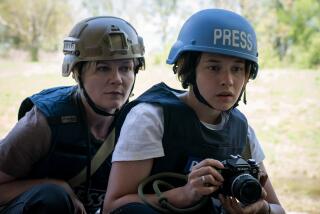Nation Watches With Curiosity and Concern as Women Go to War : Military: 30,000 of them are serving in the Gulf. By every measure, they are meeting the challenge.
EASTERN SAUDI ARABIA — “I am,” says Natalie Applegate, “a soldier first. And I’ve got to do a soldier’s job. Whatever it takes.”
Even at the risk of capture, or death.
Pfc. Applegate is a female. That’s how they are universally known in the military in the Persian Gulf War theater.
They number about 30,000, or 6% of the troop total. By every possible measure--and it has been measured many times and in many ways--these females are shouldering their fair 6% share of the heavy load here--save service in fighter aircraft and infantry and artillery units.
And the women of the U.S. armed forces carry a little extra burden too. With each escalation of the war, each new encounter, each twist of events, women must endure the curiosity of their nation, which never before has sent so many of them into such grave danger or expected so much of them as in Operation Desert Storm.
The listing of a female Army soldier as missing in action has renewed interest and concern about American women at war.
No better place to satisfy this curiosity than at the 937th Army Engineering Group. By one count, the group has the greatest concentration of females of any unit in the forward combat area, two officers and 12 enlisted women.
They are not on the so-called front lines, because Congress passed a law in the early 1970s prohibiting women’s direct involvement in combat. That means no deployment in attack or fighter aircraft, nor in infantry or artillery units. But in this deadly age of warfare, with long-distance weaponry, lightning-fast delivery and tactics of stealth, danger acknowledges no line in the sand.
Army Transportation Spec. Melissa Ann Rathbun-Nealy, 20, is evidence of that. Her parents in Michigan announced on Friday that they had been informed by the military that she was missing in action, lost with a male soldier on a desert road in Saudi Arabia, near the Kuwaiti border. Initial accounts had it that this was the first female MIA since World War II.
“A lot of people say, ‘Well you shouldn’t be out here.’ But we don’t need anything special,” said Pfc. Applegate, the 937th Engineering Group’s armorer.
“It makes you proud to know you’re the first women up here.”
The idea of women in combat zones may be new to some Americans, but the idea of women making the 937th function is old hat. They’ve been at it for several years and, since their arrival in the Saudi desert, have unloaded equipment trucks, strung concertina wire, dug bunkers and sounded off gung-ho, just the same as the men. By the looks of it, the only ones to pay attention to gender, at least openly, are the reporters who visit.
The easy part of the women-at-war story has been well-established. Females display the same determination, voice the same fears, pull the same duty, brave the same dangers and, yes, wear the same pants as men. A cryptic account from one combat pool reporter said additionally, “American Army women are believed to have been involved in helping to repel an Iraqi attack on American front lines.”
No details were given.
But the second wave of press inquiry about women at war has been more, well, delicate.
A reporter for a women’s magazine raised eyebrows with her questions about the love life of females at war. The answer making the rounds is that it’s better than for men, but perhaps only because there are 100 men for every six women in the military and there is no consorting between American GIs and Arab women.
Even still, it’s not great.
Insofar as is known, there are no women with private quarters in forward units. At the 937th, female officers sleep in a tent with male officers, partitions providing a visual shield but no real privacy. Enlisted women have their own group tent.
Even a cub reporter can figure that out.
As women tell it, the demands and dangers of war have tightly bound together small units like the 937th. “Our company’s not like a company--it’s more like a family,” said clerk Ginny Thomas.
But there are some touching stories of love at war.
One of them is the story of Air Force Staff Sgt. Allen Hixon and Sgt. Cindy Erickson. Often, they can be seen loading bombs on A-10 attack jets at an air base here, trying to keep to a hectic turn-around schedule in the unrelenting air war, and to keep loving watch over each other at the same time.
“I’d rather be here than at some other base to keep an eye on her,” said Hixon. “If she was at another base, we’d kind of be worried about each other. And if she was at home, she’d be worrying about me. So we might as well be together.”
The two were married 13 months ago and flew to Saudi Arabia together on Aug. 22, among the earliest U.S. military arrivals. They were separated for a while, assigned to different bases, and had to be content with an air-mail shuttle of letters. The Air Force later granted Erickson’s request for a transfer to be nearer her husband.
But not exactly near enough.
There are no quarters in the war zone for couples. Hixon shares a tent with 11 other men; Erickson is in a tent with other women.
Some of the information in this report was obtained from pool dispatches.
More to Read
Sign up for Essential California
The most important California stories and recommendations in your inbox every morning.
You may occasionally receive promotional content from the Los Angeles Times.










